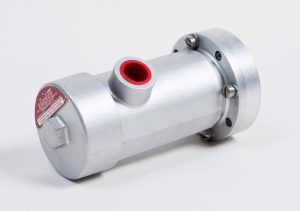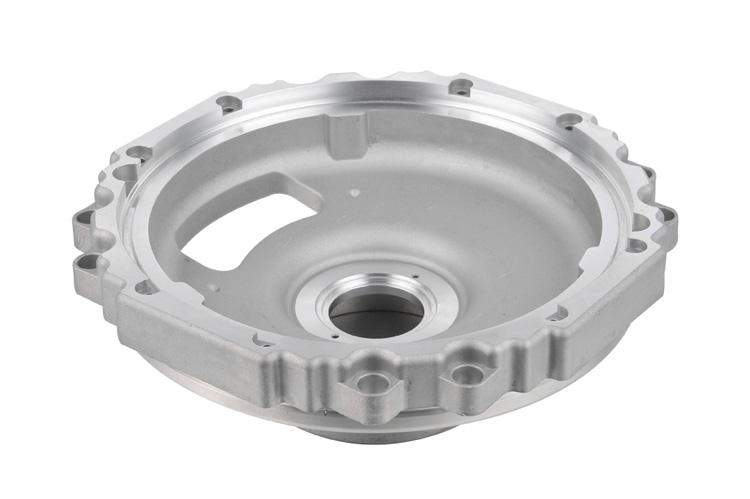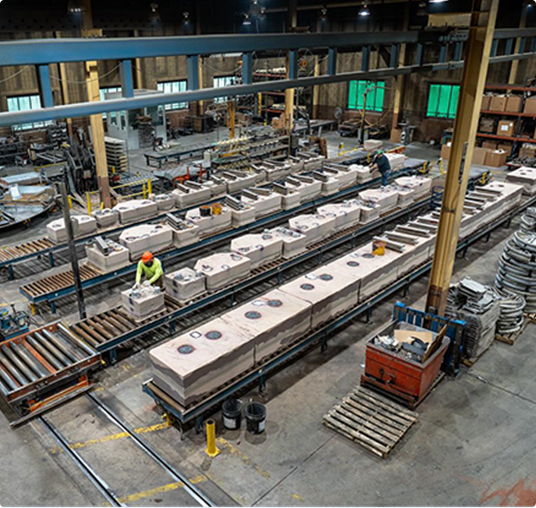Wisconsin Aluminum Foundry and Aluminum Castings: partners in production excellence
Discovering the Perks and Practical Utilizes of Aluminum Castings in Today's Market
Aluminum castings have come to be significantly pertinent in numerous markets because of their distinct qualities. Their light-weight nature and resistance to deterioration make them suitable for requiring applications. In addition, the premium strength-to-weight ratio offers substantial advantages in style and manufacturing. As markets proceed to discover their possibility, the complete scope of aluminum castings' benefits and applications stays to be totally uncovered. What lies in advance for this flexible material?
The Lightweight Benefit of Light Weight Aluminum Castings
Although numerous materials are used in manufacturing, light weight aluminum castings stand out mostly due to their lightweight buildings. This characteristic makes light weight aluminum spreadings an eye-catching choice for numerous markets, especially in aerospace and automobile applications, where weight decrease is important for improving fuel efficiency and performance. The light-weight nature of aluminum enables producers to develop components that are less complicated to manage and mount, eventually lowering labor expenses.
The capacity to generate complicated forms without significant weight charges makes it possible for designers to innovate while maintaining structural stability. Aluminum castings can efficiently change larger products, causing substantial financial savings in delivery and operational costs. Their light-weight advantage likewise adds to improved product durability, as lighter parts commonly cause reduced damage on equipment. In general, the lightweight properties of light weight aluminum castings supply makers with an affordable edge, promoting developments in item style and performance across different sectors.

Exceptional Corrosion Resistance
Light weight aluminum castings possess a natural resistance to oxidation, which substantially improves their long life in various environments. This fundamental residential or commercial property not just contributes to their longevity yet also straightens with the lightweight advantage that light weight aluminum offers. Consequently, light weight aluminum spreadings are significantly recognized for their phenomenal rust resistance in many applications.

Normally Immune to Oxidation
Among the standout characteristics of light weight aluminum castings is their exceptional deterioration resistance, which stems from a natural oxidation procedure. When revealed to air, light weight aluminum reacts to create a slim, protective layer of light weight aluminum oxide. This layer serves as an obstacle against additional oxidation and protects the underlying steel from destructive components such as dampness and salts. Unlike other steels, this oxide layer is self-repairing; if harmed, it rapidly reforms when revealed to air. This one-of-a-kind building improves the long life of light weight aluminum spreadings in numerous atmospheres, making them suitable for applications in markets such as aerospace, vehicle, and marine. The natural resistance to oxidation significantly minimizes maintenance prices and raises the dependability of aluminum castings in demanding conditions.
Lightweight Toughness Advantage
The light-weight nature of aluminum castings contributes significantly to their toughness, making them a beneficial selection in various industries. This remarkable longevity is largely credited to light weight aluminum's innate resistance to deterioration, which is boosted further via anodizing and various other surface area treatments. Unlike several steels, aluminum does not corrosion; rather, it forms a safety oxide layer that guards it from environmental damage. This building is particularly advantageous in sectors such as vehicle and aerospace, where weight reduction is critical without endangering stamina. In addition, the long life of aluminum spreadings decreases upkeep expenses and replacements, giving economic benefits gradually. Their lightweight resilience and rust resistance placement light weight aluminum castings as a superior material for contemporary production applications.

Superior Strength-to-Weight Proportion
An amazing quality of aluminum castings is their premium strength-to-weight ratio, which makes them highly desirable in various applications. This innate residential or commercial property permits aluminum spreadings to stand up to significant anxiety while remaining light-weight, an important consider industries such as aerospace, auto, and manufacturing. Designers typically choose aluminum spreadings for components that need both longevity and lowered weight, boosting fuel effectiveness and efficiency.
The high strength-to-weight ratio additionally promotes the style of elaborate shapes and frameworks, making light weight aluminum castings functional for complex applications. The capability to preserve architectural integrity under challenging conditions warranties long life and reliability in products, from aircraft frames to auto components. This advantage adds to the growing trend of utilizing aluminum spreadings in innovative styles, inevitably leading to boosted performance and performance throughout varied industries. The superior strength-to-weight proportion of light weight aluminum castings places them as a critical product in modern-day design and manufacturing.
Cost-Effectiveness in Manufacturing
Cost-effectiveness in aluminum spreading production is mainly achieved with lowered material waste and efficient production processes. By maximizing designs and using innovative techniques, makers can minimize excess material usage while preserving top quality standards. This technique not only decreases manufacturing expenses yet also adds to extra sustainable methods within the market.
Reduced Material Waste
Minimizing product waste in light weight aluminum spreading procedures significantly improves production effectiveness. By maximizing the layout and production techniques, companies can reduce excess scrap and enhance resource usage. This reduction in waste not only reduces material expenses however likewise adds to a more sustainable production model. The ability to recycle aluminum further supports cost-effectiveness, enabling producers to recover and reuse materials without compromising top quality. As the market progressively concentrates on sustainability, decreased material waste aligns with ecological objectives while all at once enhancing profitability. Inevitably, efficient use raw products reinforces the affordable position of organizations out there, making aluminum castings a positive choice in different applications. The tactical approach to decreasing waste shows a commitment to both economic and ecological obligation.
Efficient Production Processes
While typical production procedures can sustain substantial prices, aluminum spreading uses an extra reliable option that enhances total production profitability. This approach reduces product waste and enables accurate control over the manufacturing process, bring about minimized labor and functional costs. The capacity to produce intricate shapes with less steps further simplifies manufacturing, adding to shorter preparations. Additionally, aluminum's light-weight nature and excellent thermal conductivity permit power cost savings throughout production and in the final application. By utilizing contemporary spreading innovations, suppliers can achieve greater throughput without sacrificing high quality. Light weight aluminum spreading stands out as a cost-effective solution, making it an appealing choice for organizations aiming to maximize their manufacturing procedures in today's competitive market.
Convenience Across Industries
Aluminum spreadings demonstrate remarkable convenience across various markets, as they can be customized to satisfy particular needs and applications. In the vehicle sector, light weight aluminum castings are used in engine blocks, transmission housings, and wheels, using lightweight yet sturdy options that boost gas efficiency. The aerospace industry likewise takes advantage of light weight aluminum castings, using them in architectural components and engine parts due to their strength-to-weight ratio.
In the durable goods field, makers utilize light weight aluminum castings for products varying from cooking equipment to furniture, offering both aesthetic allure and capability. The electronic devices market utilizes aluminum spreadings for real estates and heat sinks, guaranteeing effective thermal monitoring. Furthermore, the building industry leverages aluminum spreadings for structural components and building aspects, enhancing durability and style adaptability. This broad applicability highlights light weight aluminum castings as an important source, satisfying the diverse needs of different markets while maintaining high efficiency and dependability.
Sustainability and Ecological Effect
As industries progressively prioritize sustainable techniques, light weight aluminum castings become a green selection because of their recyclability and reduced ecological footprint. Aluminum is one of the most recycled products internationally, with the ability to be repurposed numerous times without degradation of high quality. This characteristic considerably minimizes the need for basic materials and power consumption related to main light weight aluminum production, which is energy-intensive.
In addition, aluminum castings add to light-weight designs, causing fuel effectiveness in transport applications such as automotive advice and aerospace sectors. Their sturdiness and resistance to corrosion expand item life expectancies, even more decreasing waste and resource use with time. Furthermore, numerous makers are adopting accountable sourcing and eco-friendly manufacturing methods, enhancing the sustainability of aluminum spreading procedures. In general, light weight aluminum spreadings stand for a practical More hints solution for businesses aiming to reduce their environmental effect while accomplishing performance and efficiency.
Developments in Aluminum Casting Technologies
Current improvements in aluminum spreading modern technologies have actually greatly boosted the effectiveness and high quality of manufacturing procedures. Developments such as 3D printing and progressed mold-making methods have allowed makers to produce complex layouts with lowered product waste. This change not only improves the precision of cast components but additionally reduces lead times, enabling fast prototyping and faster market entry.
The unification of advanced computer system simulations aids in predicting possible defects throughout spreading, leading to higher-quality outcomes. The usage of lightweight alloys has actually additionally added to the advancement of more powerful, much more long lasting items, satisfying sectors ranging from vehicle to aerospace
In addition, automated casting processes have actually emerged, reducing human mistake and increasing production rate. Jointly, these technologies are transforming the aluminum spreading landscape, driving better competitiveness and sustainability in manufacturing. As markets remain to progress, these technologies will play a necessary duty in conference future demands for efficiency and high quality.
Regularly Asked Inquiries
How Do Aluminum Castings Compare to Other Steels in Terms of Thermal Conductivity?
Aluminum castings display remarkable thermal conductivity contrasted to several metals, such as steel and iron - Wisconsin Aluminum Foundry. Their light-weight nature and efficient heat distribution make them optimal for applications needing efficient thermal monitoring in various markets
What Are the Typical Problems Located in Aluminum Castings?
Usual problems in aluminum spreadings include porosity, shrinking, incorporations, and surface irregularities. These problems usually arise from improper cooling prices, poor mold and mildew style, or contaminations, affecting the general high quality and performance of the end product.
Can Light Weight Aluminum Castings Be Recycled, and Exactly how?
Light weight aluminum spreadings can be reused successfully. The process involves accumulating, melting, and changing the aluminum, which reduces waste and conserves sources. This reusing adds to sustainability while maintaining the product's residential or commercial properties for future use.
What Are the Typical Lead Times for Light Weight Aluminum Spreading Production?
Typically, preparations for aluminum spreading manufacturing variety from 2 to six weeks, depending on variables such as complexity, tooling demands, and production quantity. Effectiveness can boost with well established provider connections and enhanced production procedures.
How Does the Surface Finish Affect Light Weight Aluminum Spreading Performance?
The surface area finish significantly impacts light weight aluminum casting efficiency by influencing rust resistance, aesthetic high quality, and rubbing attributes. A smoother finish improves resilience and capability, while a rougher texture can improve bond for succeeding finishings or therapies.
Numerous products are used in manufacturing, light weight aluminum spreadings stand out mainly due to their lightweight residential properties. When exposed to air, light weight aluminum responds to form a thin, protective layer of aluminum oxide. Cost-effectiveness in light weight aluminum casting production is mostly accomplished via minimized product waste and efficient manufacturing procedures. Lowering material waste in aluminum casting procedures greatly enhances production effectiveness. her comment is here Inevitably, reliable use of raw materials enhances the competitive position of organizations in the market, making light weight aluminum spreadings a beneficial choice in numerous applications.